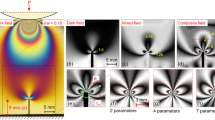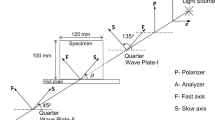Abstract
For isotropic material structure, the stress in the vicinity of crack tip is generally much higher than the stress far away from it. This phenomenon usually leads to stress concentration and fracture of structure. Previous researches and studies show that the stress intensity factor is one of most important parameter for crack growth and propagation. This paper provides a convenient numerical method, which is called hybrid photoelasticity method, to accurately determine the stress field distribution in the vicinity of crack tip and mixed-mode stress intensity factors. The model was simulated by finite element method and isochromatic data along straight lines far away from the crack tip were calculated. By using the isochromatic data obtained from finite element method and a conformal mapping procedure, stress components and photoelastic fringes in the hybrid region were calculated. To easily compare calculated photoelastic fringes with experiment results, the fringe patterns were reconstructed, doubled and sharpened. Good agreement shows that the method presented in this paper is reliable and convenient. This method can then directly be applied to obtain mixed mode stress intensity factors from the experimentally measured isochromatic data along the straight lines.
Similar content being viewed by others
References
J. W. Dally and W. F. Riley, Experimental stress analysis, 3rd Edition, McGraw-Hill, Inc. New York, USA (1991).
A. S. Kobayshi, Handbook on experimental mechanics, Second Revised Edition, Society for Experimental Mechanics, VCH Publishers, Inc., New York, USA (1993).
E. Collett, Polarized light: Fundamentals and Applications, Marcel Dekker, Inc., New York, USA (1993).
G. D. Gerhardt, A hybrid/finite element approach for stress analysis of notched anisotropic materials, ASME Journal of Applied Mechanics, 51 (1984) 804–810.
T. H. Baek and T. J. Rudolphi, A hybrid stress measurement using only x-displacement by phase shifting method with fourier transform (PSM/FT) in laser speckle interferometry and least squares method, International Journal of Precision Engineering and Manufacturing, 11(1) (2010) 49–54.
T. H. Baek, Photoelastic stress analysis by use of hybrid technique and fringe phase shifting method, Journal of Experimental Mechanics, 21(1) (2006) 87–95.
T. H. Baek, Measurement of stress distribution around a circular hole in a plate under bending moment using phase-shifting method with reflective polariscope arrangement, Journal of Solid Mechanics and Material Engineering, 2(4) (2008) 549–556.
T. H. Baek, T. J. Chung and H. Panganivan, Full-field stress determination around circular discontinuity in a tensile-loaded plate using x-displacements only, Journal of Solid Mechanics and Material Engineering, 2(6) (2008) 756–762.
T. H. Baek, H. Panganiban and T. J. Chung, A hybrid photoelastic stress analysis around holes in tensile-loaded plates using isochromatic data and finite element method, Lecture Series on Computer and Computational Sciences, 8, Brill Academic Publishers, The Netherlands (2007) 21–25.
T. H. Baek, M. S. Kim, J. Rhee and R. E. Rowlands, Hybrid stress analysis of perforated tensile plates using multiplied and sharpened photoelastic data and complex-variable techniques, JSME International Journal, Series A: Solid Mechanics and Material Engineering, 43(4) (2000) 327–333.
O. S. Lee, J. C. Park and G. H. Kim, Dynamic mixed mode crack propagation behavior of structural bonded joints, KSME International Journal, 14(7) (2000) 752–763.
J. S. Hawong, J. H. Nam, K. H. Kim, O. S. Kwon, G. Kwon and S. H. Park, A study on the development of photoelastic experimental hybrid method for color isochromatics, Journal of Mechanical Science and Technology, 24(6) (2010) 1279–1287.
J. S. Hawong, C. H. Lin, S. T. Lin, J. Rhee and R. E. Rowlands, A hybrid method to determine individual stresses in orthotropic composites using only measured isochromatic data, Journal of Composite Material, 29(18) (1995) 2366–2387.
G. N. Savin, Stress concentration around holes, Pergamon Press, New York, USA (1961).
R. J. Sanford, Application of the least squares method to the photoelastic analysis, Experimental Mechanics, 20(6) (1980) 192–197.
T. H. Baek and J. C. Lee, Development of image processing technique for photoelastic fringe analysis, Transactions of Korean Society for Mechanical Engineers, 18(10) (1994) 2577–2584.
T. H. Baek, Digital image processing technique for photoelastic isochromatic fringe sharpening, Journal of the Korean Society for Precision Engineering, 10(3) (1993) 220–230.
T. H. Baek and C. P. Burger, Accuracy improvement technique for measuring stress intensity factor in photoelastic experiment, KSME International Journal, 5(1) (1991) 22–27.
ABAQUS analysis user’s manual, ABAQUS Inc., Providence, RI 02909, USA.
L. Chen, S. Jin, B. H. Lee, M. S. Kim and T. H. Baek, Analysis of photoelastic stress field around inclined crack tip by using hybrid technique, Transactions of Korean Society for Mechanical Engineers A, 34(9) (2010) 1287–1292.
T. L. Anderson, Fracture mechanics, 3rd Ed., CRC Press Taylor & Francis Group, USA (2005).
T. H. Baek, H. Panganiban, C. T. Lee and T. J. Chung, Hybrid full-field stress analysis around holes in tensile-loaded plates by Phase-shifting photoelasticity, Key Engineering Materials, 345–346 (2007) 865–868.
Author information
Authors and Affiliations
Corresponding author
Additional information
This paper was recommended for publication in revised form by Associate Editor Vikas Tomar
Tae Hyun Baek received a B.S degree in Mechanical Engineering from Hanyang University in 1971. Then he received his M.S degree in 1984 and Ph. D degree in 1986 from Iowa State University in USA, respectively. Dr. Baek is currently a professor of Mechanical and Automotive Engineering at Kunsan National University, Jeonbuk, Korea. Prof. Baek’s research interests include experimental stress analysis, finite element method and numerical analysis, etc.
Lei Chen received a B.S degree in Mechanical Engineering from Qingdao Ocean University in 2002. Then he received his M.S degree from Ocean University of China in 2006. Mr. Chen is currently a Ph.D. candidate at the graduate school of Kunsan National University, in Kunsan city, Korea. Mr. Chen’s research interests include stress analysis, experimental mechanics and topology optimization, etc.
Rights and permissions
About this article
Cite this article
Baek, T.H., Chen, L. & Hong, D.P. Hybrid determination of mixed-mode stress intensity factors on discontinuous finite-width plate by finite element and photoelasticity. J Mech Sci Technol 25, 2535–2543 (2011). https://doi.org/10.1007/s12206-011-0740-1
Received:
Revised:
Accepted:
Published:
Issue Date:
DOI: https://doi.org/10.1007/s12206-011-0740-1




